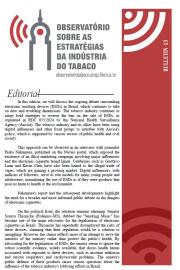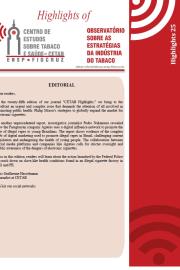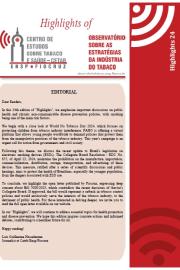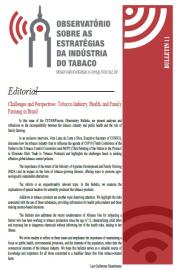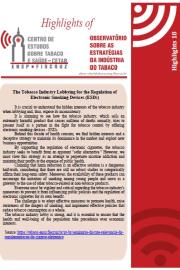''Litigation''
"The tobacco industry defies the law and tries to intimidate its opponents into litigation."1
The industry often uses litigation against its critics, tobacco control programs and regulation that affects its sales. Historically, the industry has always tried to influence policy through legislation, either directly or through third parties. At the same time, lawyers working for the industry have influenced the way they investigate and report on the health effects of smoking.
Opposing Media Campaigns in the US
- Since 1969, Philip Morris has discussed legal strategies to contain tobacco control media campaigns.
- In the early 1990s, the industry considered using lawsuits to eradicate critical messages from the industry, shortly after California launched its first anti-tobacco advertising campaign. The "Industry Spokesperson" ad "depicted a smoky meeting with tobacco industry executives and their leader, in an ironic tone, communicating that the industry would need to recruit about 3,000 new smokers daily because 2,000 people would quit and another 1,100 would die". A decade later, two companies, RJ Reynolds and Lorillard Tobacco Company, challenged the Californian campaign in court, in 2002 and 20032
- In 2006, an article in Tobacco Control magazine noted that the "tobacco industry has expanded its efforts to oppose tobacco control media campaigns through litigious strategies."3
Lawyers limit the health debate
A study that investigated the influence of industry lawyers themselves on scientific research concluded that:
"Tobacco industry lawyers have engaged in activities that have little or nothing to do with the practice of law, including calibrating and trying to influence scientists' beliefs, criticizing internal scientific research, and advising their researchers not to publish potentially discrediting results. Tobacco-related illnesses have proliferated partly because of tobacco industry advocates."4
Intimidating Critics
There have been occasions when the industry has threatened its critics with legal action:
In the mid-1990s, Dr. Jeffrey Wigand gained national notoriety in the US when he became the first high-level industry executive to reveal secrets about health and tobacco issues. A lawsuit was filed against him by Brown & Williamson, a subsidiary of BAT, which was filed, thanks to the landmark June 20, 1997 settlement worth $368 billion between the Attorneys General of 40 states and the tobacco industry. Wigand later achieved international fame when he had his role in the case represented by actor Russell Crowe in the film entitled ''The Insider'' (The Insider)5
Using the freedom of information law
The tobacco industry has used the Freedom of Information Acts (FOIA) on several occasions in Australia, the US and the UK. It's not a new tactic. As early as the 1990s, one of the most respected tobacco control researchers, Dr Stanton Glantz, the Director of the Center for Tobacco Control Research and Education at the University of California, reported that Philip Morris was "using FOIA to impede progress" of your search.6
In the mid-1990s, the US Tobacco Institute noted how FOIA was being used as an intelligence aggregation exercise: "State-level FOIA-like requirements have proven our most useful means of gathering information about our adversaries."7
A recent scientific study from New Zealand concluded that: “The tobacco industry portrays itself as a corporately and socially responsible company. Furthermore, it abuses legal ploys originally designed to protect the public's right to have access to official information."8
New Zealand is not an isolated case. In 2011, Philip Morris used Freedom of Information (FOI) requirements to gain access to University of Stirling research data on smoking among young people. This took energy, time and money from the Stirling School of Business; the industry had access to research that had been used to define new laws, and could use its insights to "influence decision makers", while at the same time misrepresenting the results and undermining the credibility of the scientists involved. This evolved into a smear campaign against Linda Bauld of Stirling University.
In September 2011, The Independent newspaper reported how, in the UK, the tobacco industry was "surreptitiously using other companies to take a stand against smoking restrictions and gain access to government documents." The article continued: "Public relations firms and law firms are working for tobacco multinationals without revealing the identity of their clients." The legal tactics employed by the tobacco industry correspond, for the most part, to influences of a beneficial nature to the administrative processes of the courts. For example, the article highlighted two cases, one in which Philip Morris lawyers attempted to gain access to data, and another in which Imperial's Tobacco Public Relations firm Bell Pottinger had used the libertarian group Big Brother Watch to try to access materials, invoking FOIA.9
related links
"FOI: SmokeFree South West"
"FOI: University of Bath"
Defying legislation, such as generic packaging
In October 2011, WHO Director General Margaret Chan accused the tobacco industry of using lawsuits to try to subvert national laws and international conventions to curb the sale of cigarettes. "It's horrible to think that an industry known for its dirty tricks is allowed to detract from something that is clearly done in the public's best interest." Chan said, citing industry lawsuits against anti-smoking measures in Australia and Uruguay, that these were scare tactics" aimed at deterring other countries from following suit. She continues: "The tobacco industry can hire the best lawyers and PR firms that money can buy. Money can speak louder than moral, ethical or public health arguments and can crush the most glaring scientific evidence."10
For more information, see:
- Plain Packaging in Australia
- Australia: Challenging Legislation
- Philip Morris vs the Government of Uruguay
In this regard, see also:
- Influencing Decision Makers
- Techniques involving Third Parties
- Revolving door
- 1. WORLD HEALTH ORGANIZATION. Tobacco industry interference with tobacco control, 2008. Disponível em: http://whqlibdoc.who.int/publications/2008/9789241597340_eng.pdf?ua=1 http://whqlibdoc.who.int/publications/2008/9789241597340_eng.pdf?ua=1. Acesso em:24 out. 2014. Documento integral em PDF: https://drive.google.com/file/d/0B0HvJttn0WXDVmJCX0RPM3ZQWnM/view?usp=sh...
- 2. JENNIFER, Ibrahim; GLANTZ, Stanton. Tobacco industry litigation strategies to oppose tobacco control media campaigns. Tobacco Control, Estados Unidos, 16 out. 2005. v. 15, n. 1, p. 50-58. Disponível em: http://tobaccocontrol.bmj.com/content/15/1/50.full.pdf+html http://tobaccocontrol.bmj.com/content/15/1/50.full.pdf+html. Acesso em: 24 nov. 2014. Documento integral em PDF: https://drive.google.com/file/d/0B0HvJttn0WXDeVNMbUY0ZFlhU2c/view?usp=sh....
- 3. ''Id. Ibid.''
- 4. GUARDINO, Sara; DAYNARD, Richard. Tobacco industry lawyers as ‘‘disease vectors’’. Tobacco Control, Estados Unidos, v. 16, n. 4, p. 224-228, out. 2006. Disponível em: http://tobaccocontrol.bmj.com/content/16/4/224.full.pdf+html http://tobaccocontrol.bmj.com/content/16/4/224.full.pdf+html. Acesso em: 24 nov. 2014. Documento integral em PDF: https://drive.google.com/file/d/0B0HvJttn0WXDcmFoWDl5b3c4ejA/view?usp=sh....
- 5. WIGAND, Jeffrey. jeffreywigand.com. Disponível em: http://www.jeffreywigand.com/bio.php http://www.jeffreywigand.com/bio.php. Acesso em: 24 nov. 2014. Documento integral em PDF: https://drive.google.com/file/d/0B0HvJttn0WXDb3dhcTdGME8wOWs/view?usp=sh....
- 6. [COVER Letter for Article on FOIA]. Legacy Tobacco Documents Library, Estados Unidos, 24 mar. 1992. Disponível em: [http://legacy.library.ucsf.edu/tid/wqf76b00/pdf http://legacy.library.ucsf.edu/tid/wqf76b00/pdf]. Acesso em: 24 nov. 2014. Documento integral em PDF: https://drive.google.com/file/d/0B0HvJttn0WXDYmwwR3FqOVltX00/view?usp=sh....
- 7. [INTRODUCTION 1996 assist research plan]. Legacy Tobacco Documents Library, Estados Unidos, 1996. Disponível em: http://legacy.library.ucsf.edu/tid/cyf26b00/pdf http://legacy.library.ucsf.edu/tid/cyf26b00/pdf. Acesso em: 24 nov. 2014. Documento integral em PDF: https://drive.google.com/file/d/0B0HvJttn0WXDemg3M3REWmVDNUk/view?usp=sh....
- 8. WONG, Grace; YOUDAN, Ben; WONG, Ron. Misuse of the Official Information Act by the tobacco industry in New Zealand. Tobacco Control, Estados Unidos, v. 19, n. 14, p. 346-347, 7 jul. 2010. Disponível em: http://tobaccocontrol.bmj.com/content/19/4/346.full.pdf+html http://tobaccocontrol.bmj.com/content/19/4/346.full.pdf+html. Acesso em: 24 nov. 2014. Documento integral em PDF: https://drive.google.com/file/d/0B0HvJttn0WXDLVFTb3NrbEVmckk/view?usp=sh....
- 9. CONNOR, Steve. Smoke and mirrors: how the tobacco industry hides behind lobbyists: PR firms and lawyers campaign without revealing clients' identity. The Independent, Inglaterra, 3 et. 2011. Disponível em: http://www.independent.co.uk/news/uk/politics/smoke-and-mirrors-how-the-... http://www.independent.co.uk/news/uk/politics/smoke-and-mirrors-how-the-.... Acesso em: 24 nov. 2014. Documento integral em PDF: https://drive.google.com/file/d/0B0HvJttn0WXDakNrN2x3WlphV0E/view?usp=sh....
- 10. MACARAIG, Mynardo. WHO chief accuses 'big tobacco' of dirty tricks. MedicalXpress, 10 out. 2011. Disponível em: http://medicalxpress.com/news/2011-10-chief-accuses-big-tobacco-dirty.html http://medicalxpress.com/news/2011-10-chief-accuses-big-tobacco-dirty.html. Acesso em: 24 nov. 2014. Documento integral em PDF: https://drive.google.com/file/d/0B0HvJttn0WXDanlaa0JFTTdPT1E/view?usp=sh....


